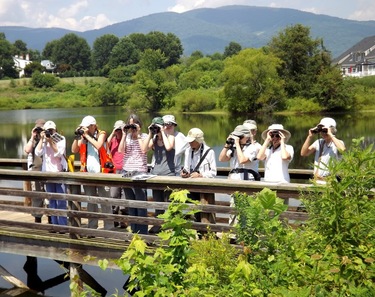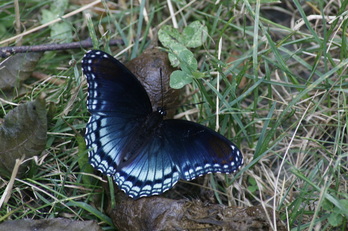 Rivanna Chapter volunteers surveying butterflies in Albemarle County. Photo by Rebecca English.
Rivanna Chapter volunteers surveying butterflies in Albemarle County. Photo by Rebecca English. By Terri Keffert, VMN Volunteer Coordinator and co-leader of the Rivanna Master Naturalist Chapter's annual butterfly count
Butterfly Identification (and Counts) are Addicting!
As I talk to more Virginia Master Naturalists (VMN) around the state, I am pleased to hear the enthusiasm from so many of them about their help with Butterfly Counts. And I know firsthand how much we all look forward to this activity each year. I co-lead a North American Butterfly Association (NABA) Count each year in Charlottesville/Albemarle County with a very excited group of volunteers from the Rivanna Chapter. I was sick for my count this year and felt the withdrawal pangs almost immediately! I couldn’t wait for the Nelson County count so that I could help with that one. I hear this same sentiment from many other VMNs, who make an effort to travel around the state helping with other counts. And who hasn’t felt a special sense of privilege or honor when a butterfly chooses to hitch a ride on our arms, hats, or backpacks, such as we’ve had Harvesters, Red Admirals, Question Marks, and others do during our Counts?
While many VMN volunteers help with these counts that are run by other groups, it made me wonder how many VMN Chapters organize a NABA count of their own. I have found four: Old Rag, Rivanna (my Chapter), Central Blue Ridge, and Historic Rivers Chapters all have been leading a NABA count each year. I reached out to the organizers of those other Chapters to lend me their data and stories to see if there were any contrasts and consistencies between the species and individuals found around the state. And here’s what I found…
First, a Quick Overview
NABA has been collecting data from butterfly counts since 1993 across the US and Canada. In 2015, there were 406 counts reported. NABA sets specific parameters that they want all the count groups to follow - most importantly, that the counts are within a 15-mile diameter circle that can then be repeated each year from that same circle, that the count is taken within one 24-hour period, and that the count last at least six field hours. Informally, most groups stay out for much longer than that, and most try to do their counts on public land within a variety of habitats, e.g., riparian, woods, meadows, etc.
The four Chapters and their VMN organizers that I have found are:
Comparing the Data
Interestingly, three of the Chapters are along the east side of the Blue Ridge and one is in Tidewater. When comparing the data between the four chapters over the last five years (2011-2016) (or three years, 2014-2016, for the Historic Rivers Chapter,) I was excited to see what differences I would find.
First, let me explain how I had to look at this data. The butterfly counts are really a snapshot in time and place. There are many different variables within each count that are unique to each group (like weather conditions, number of hours and sites counted, level of knowledge of the participants, and geographic habitats.) These make it impossible to do a straight comparison, beyond species present/absence. Relative numbers in the end showed no real correlation between groups, only within each group, due to all the variables just mentioned. Also, because skipper identification can be difficult and the ability to accurately identify them varies so greatly between participants, I took that category out of the comparison.
So what did I find? Looking at species presence/absence between the regions, what a surprise (or not) it was to find that all four regions had most of the same species! This was despite the huge variabilities that each had. All four regions had large quantities of ‘the Big Three': Eastern Tiger Swallowtail, Cabbage Whites, and Eastern Tailed Blues, (plus one, the Silvery Checkerspot, if you don’t count the HRMN region where they don’t appear.) No surprise there, either. And kudos to the ORMN – they had the state record for the most Eastern Tiger Swallowtails seen on a count – 2375, in 2013!! Many years they have seen over 600, but that year was outstanding!
While 2010 predated the start of the other three counts, that year had an exponential increase in the number of individual butterflies for the CBRMN count – over four times the usual average total amount. And in particular, those Big Three plus One species. Why 2010? We may never know without a broader data base and climate variabilities of what was happening in Virginia that year.
Susan McSwain (CBRMN) remembers 2010 with fondness as the “Red-spotted Purple Year.”
Butterfly Identification (and Counts) are Addicting!
As I talk to more Virginia Master Naturalists (VMN) around the state, I am pleased to hear the enthusiasm from so many of them about their help with Butterfly Counts. And I know firsthand how much we all look forward to this activity each year. I co-lead a North American Butterfly Association (NABA) Count each year in Charlottesville/Albemarle County with a very excited group of volunteers from the Rivanna Chapter. I was sick for my count this year and felt the withdrawal pangs almost immediately! I couldn’t wait for the Nelson County count so that I could help with that one. I hear this same sentiment from many other VMNs, who make an effort to travel around the state helping with other counts. And who hasn’t felt a special sense of privilege or honor when a butterfly chooses to hitch a ride on our arms, hats, or backpacks, such as we’ve had Harvesters, Red Admirals, Question Marks, and others do during our Counts?
While many VMN volunteers help with these counts that are run by other groups, it made me wonder how many VMN Chapters organize a NABA count of their own. I have found four: Old Rag, Rivanna (my Chapter), Central Blue Ridge, and Historic Rivers Chapters all have been leading a NABA count each year. I reached out to the organizers of those other Chapters to lend me their data and stories to see if there were any contrasts and consistencies between the species and individuals found around the state. And here’s what I found…
First, a Quick Overview
NABA has been collecting data from butterfly counts since 1993 across the US and Canada. In 2015, there were 406 counts reported. NABA sets specific parameters that they want all the count groups to follow - most importantly, that the counts are within a 15-mile diameter circle that can then be repeated each year from that same circle, that the count is taken within one 24-hour period, and that the count last at least six field hours. Informally, most groups stay out for much longer than that, and most try to do their counts on public land within a variety of habitats, e.g., riparian, woods, meadows, etc.
The four Chapters and their VMN organizers that I have found are:
- Historic Rivers Chapter (HRMN), in the Williamsburg area, organized by Adrienne Frank. First NABA count was in 2014.
- Old Rag Chapter (ORMN), in the Madison/Culpeper areas, organized by Caroline Watts. First NABA count was in 2011.
- Central Blue Ridge Chapter (CBRMN), in Nelson County, organized by Susan McSwain. First NABA count was in 2000 (by Dick Smythe, when it wasn’t primarily done by VMNs); now by Susan since 2011.
- Rivanna Chapter (RMN), in the Charlottesville and Albemarle County areas, organized by Nancy Weiss and Terri Keffert. First NABA count was in 2011.
Comparing the Data
Interestingly, three of the Chapters are along the east side of the Blue Ridge and one is in Tidewater. When comparing the data between the four chapters over the last five years (2011-2016) (or three years, 2014-2016, for the Historic Rivers Chapter,) I was excited to see what differences I would find.
First, let me explain how I had to look at this data. The butterfly counts are really a snapshot in time and place. There are many different variables within each count that are unique to each group (like weather conditions, number of hours and sites counted, level of knowledge of the participants, and geographic habitats.) These make it impossible to do a straight comparison, beyond species present/absence. Relative numbers in the end showed no real correlation between groups, only within each group, due to all the variables just mentioned. Also, because skipper identification can be difficult and the ability to accurately identify them varies so greatly between participants, I took that category out of the comparison.
So what did I find? Looking at species presence/absence between the regions, what a surprise (or not) it was to find that all four regions had most of the same species! This was despite the huge variabilities that each had. All four regions had large quantities of ‘the Big Three': Eastern Tiger Swallowtail, Cabbage Whites, and Eastern Tailed Blues, (plus one, the Silvery Checkerspot, if you don’t count the HRMN region where they don’t appear.) No surprise there, either. And kudos to the ORMN – they had the state record for the most Eastern Tiger Swallowtails seen on a count – 2375, in 2013!! Many years they have seen over 600, but that year was outstanding!
While 2010 predated the start of the other three counts, that year had an exponential increase in the number of individual butterflies for the CBRMN count – over four times the usual average total amount. And in particular, those Big Three plus One species. Why 2010? We may never know without a broader data base and climate variabilities of what was happening in Virginia that year.
Susan McSwain (CBRMN) remembers 2010 with fondness as the “Red-spotted Purple Year.”
“As the leader of the Nelson Count, every year I keep hoping for another "Red-spotted Purple Year!" In 2010, we counted 136 Purples, with a whopping 129 of them being on a single segment of the County route. By car and foot, we traversed a three mile gravel road, with lovely Purples around every bend. These butterflies are truly accommodating to counters. They sit still on the ground, wings outstretched, ever so often lazily closing their wings above their back. With brilliant colors on both sides of their wings, they are eye candy. Except for 2010, during the 17 years of the Count, the average number of Purples seen on County Day has been eight. This year, 2016, we did not see a single Purple. Maybe 2017 will be another grand year for Purples! I can always hope!”
Data Observations
Take the following tables with a grain of salt. Unless noted, Glassberg (see reference below) said that these species should have been present. Perhaps they might not have been seen in a region due to time of year (many more Mourning Cloaks are seen in the spring) or not having the right habitat (RMN count may not have seen Juniper Hairstreaks due to a lack of Red Cedar (Juniperus virginiana) stands in their region; likewise with Zebra Swallowtails and their host tree, Pawpaw (Asimina triloba) in the CBRMN count.)
Take the following tables with a grain of salt. Unless noted, Glassberg (see reference below) said that these species should have been present. Perhaps they might not have been seen in a region due to time of year (many more Mourning Cloaks are seen in the spring) or not having the right habitat (RMN count may not have seen Juniper Hairstreaks due to a lack of Red Cedar (Juniperus virginiana) stands in their region; likewise with Zebra Swallowtails and their host tree, Pawpaw (Asimina triloba) in the CBRMN count.)
Species Not Seen At All in Some Counts
Common Name |
Not seen by which Chapter |
Comments |
Glassberg agrees it shouldn't be seen there |
Black Swallowtail |
Central Blue Ridge |
Last seen in 2008 (one) |
|
Zebra Swallowtail |
Central Blue Ridge |
Last seen in 2011 (one) |
|
Harvester |
Old Rag, Historic Rivers |
||
Little Yellow Sulphur |
Historic Rivers |
Yet seen at Chippokes State Park across the river |
|
Juniper Hairstreak |
Rivanna |
No red cedar stands? |
|
Great Spangled Fritillary |
Historic Rivers |
Agrees - too far south |
|
Meadow Fritillary |
Historic Rivers, Rivanna, Central Blue Ridge |
Agrees - in northern latitudes and higher elevations which Old Rad Chapter is in |
|
Silvery Checkerspot |
Historic Rivers |
Agrees - too far southeast |
|
Tawny Emperor |
Rivanna, Historic Rivers |
Species Seen By Only One Chapter
Common Name |
Seen only by which Chapter |
Comments |
Glassberg agrees it should be seen there |
Appalachian Brown |
Historic Rivers |
habitat: wet woods (marshes) |
Agrees. But why not our other regions? No wet woods? |
Gemmed Satyr |
Historic Rivers |
Agrees - in the south only |
|
American Copper |
Old Rag |
Agrees - more north/mountains by this time of year |
Some make sense – according to Glassberg, Meadow Fritillaries are seen in the more northern latitudes and higher elevations, so it isn’t unexpected that the ORMN count would see them.
Surprisingly, Appalachian Browns were seen every year at HRMN, yet not in the mountains, belying their name. It makes sense for HRMN, since that species’ habitat is in wet/marshy woods, areas which Tidewater has many. But Glassberg says they are commonly found in the northern latitudes and mountains, so why haven’t the other counts seen any? Again, is it due to the lack of preferred habitat in those count regions?
So does weather have anything to do with the number of species counted? Not that I could discern from the limited data given me. If the wind, temperature ranges, and lack of rain were agreeable, then specific temperatures and percentage of sun did not seem to make a difference. Again, there are so many other variables between regions that it is hard to determine any correlation between groups for their species diversity and numbers using just weather data.
Disappearing Habitat
Adrienne reminds us of the challenges that beset the butterflies and their future. She and her husband, Gary, are avid butterfly enthusiasts. Besides leading their own HRMN Chapter’s count, they also participate in other counts around the state and do off-season counts in their Williamsburg area. Adrienne sadly described areas where they have counted which have fallen victim to development, ‘aesthetic mowing’, and even the removal of riparian habitat and butterfly-friendly gardens that were intentionally created. State parks are not immune to this, as she has witnessed, and asks everyone to educate and impress upon your state and local parks the awareness and importance of keeping butterfly habitat around. It does work – she said that administrators for the James City County parks have been very open to learning and using alternative mowing strategies and planting native host plants in the parks there.
So many thanks to Adrienne, Caroline, Susan, and Nancy for the sharing of their data, stories, and enthusiasm for butterflies! And to all the many volunteers who have helped with these counts over the years. If you have never helped with a count before and are now intrigued, keep an eye open next year for word about counts happening around you! Yes, you CAN identify butterflies, even if you don’t think you know any of them. Guaranteed you will know at least seven by the time you’re done for the day. You learn quickly in the field, and we always need people to record and photograph. You might also check the NABA website map, where you can find ones happening around the state. What better way to get in VMN volunteer hours, help the conservation of these wonderful creatures, and share a camaraderie at the same time! You’ll get to know your fellow VMNs better as you share stories around the lunch or dinner table after a good day out.
Reference: Glassberg, Jeffrey. Butterflies through Binoculars: The East. New York: Oxford University Press, 1999.
Surprisingly, Appalachian Browns were seen every year at HRMN, yet not in the mountains, belying their name. It makes sense for HRMN, since that species’ habitat is in wet/marshy woods, areas which Tidewater has many. But Glassberg says they are commonly found in the northern latitudes and mountains, so why haven’t the other counts seen any? Again, is it due to the lack of preferred habitat in those count regions?
So does weather have anything to do with the number of species counted? Not that I could discern from the limited data given me. If the wind, temperature ranges, and lack of rain were agreeable, then specific temperatures and percentage of sun did not seem to make a difference. Again, there are so many other variables between regions that it is hard to determine any correlation between groups for their species diversity and numbers using just weather data.
Disappearing Habitat
Adrienne reminds us of the challenges that beset the butterflies and their future. She and her husband, Gary, are avid butterfly enthusiasts. Besides leading their own HRMN Chapter’s count, they also participate in other counts around the state and do off-season counts in their Williamsburg area. Adrienne sadly described areas where they have counted which have fallen victim to development, ‘aesthetic mowing’, and even the removal of riparian habitat and butterfly-friendly gardens that were intentionally created. State parks are not immune to this, as she has witnessed, and asks everyone to educate and impress upon your state and local parks the awareness and importance of keeping butterfly habitat around. It does work – she said that administrators for the James City County parks have been very open to learning and using alternative mowing strategies and planting native host plants in the parks there.
So many thanks to Adrienne, Caroline, Susan, and Nancy for the sharing of their data, stories, and enthusiasm for butterflies! And to all the many volunteers who have helped with these counts over the years. If you have never helped with a count before and are now intrigued, keep an eye open next year for word about counts happening around you! Yes, you CAN identify butterflies, even if you don’t think you know any of them. Guaranteed you will know at least seven by the time you’re done for the day. You learn quickly in the field, and we always need people to record and photograph. You might also check the NABA website map, where you can find ones happening around the state. What better way to get in VMN volunteer hours, help the conservation of these wonderful creatures, and share a camaraderie at the same time! You’ll get to know your fellow VMNs better as you share stories around the lunch or dinner table after a good day out.
Reference: Glassberg, Jeffrey. Butterflies through Binoculars: The East. New York: Oxford University Press, 1999.



 RSS Feed
RSS Feed